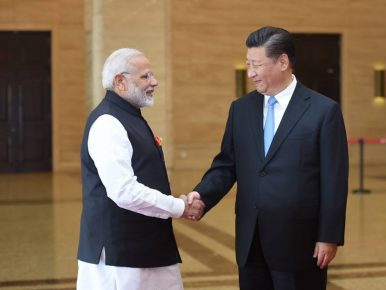By Abhijnan Rej
Earlier today, China released the latest iteration of its Defense White Paper. At a time when strategic competition between that country and the United States in the Indo-Pacific runs the risk of transforming into an outright adversarial relationship, the document has already been analyzed extensively by American experts on social media. From New Delhi’s perspective, the document is unlikely to raise alarm, with the 16 or so references to India in it being largely benign.
That said, one curious India-specific reference in the White Paper is that the PLA will “take effective measures to create favorable conditions for the peaceful resolution of the Donglang (Doklam) standoff.” The tense structure and phrasing of the sentence suggests that the tussle over Doklam is far from over, despite a simultaneous disengagement by both sides on technical terms in that area in August 2017.
It is however the White Paper’s reference to China’s “right to install to build infrastructure and deploy necessary defensive capabilities on the islands and reefs in the South China Sea,” that has struck many analysts as the chief novelty in that document. As The Diplomat’s Senior Editor Ankit Panda noted in a tweet, this is a direct turn around from Chinese President Xi Jinping’s 2015 commitment to not militarize these features. Coming as it does while the People’s Republic finds itself embroiled in crises in the South China Sea – with Vietnam and Philippines – the White Paper’s position about that maritime theater will be widely scrutinized.
It is important to note that India is unlikely to be ruffled by this. Following the informal Wuhan Summit between Xi and Prime Minister Narendra Modi in April 2018, India has embarked on a quiet mission to recalibrate its ties with China and appears reluctant to take Beijing head-on over and in the South China Sea. Three data points triangulate this shift.
First, New Delhi was quick to dismiss a news report from Hanoi last July that stated that India had gone ahead with the sale of the supersonic Brahmos cruise missile to Vietnam even though both countries have been discussing this possibility for a few years as part of a deepening defense relationship. (Several Indian analysts have advocated the sale of the Brahmos to Vietnam as a sort of ‘payback’ for China’s military support to Pakistan.) In fact, knowledgeable New Delhi-based analysts have noted the stalled progress in the India-Vietnam strategic relationship across multiple areas. On its part, Hanoi has unambiguously opposed the militarization of the U.S.-Japan-Australia-India ‘quad’ as it plays a delicate game of balancing against China while avoiding directly provoking Beijing on its own.
Second, when it comes to India’s commercial stakes in the South China Sea, much had been made in the past of Delhi’s decision to explore a hydrocarbon block in there in waters claimed by both Vietnam and China, in 2014. However, in March this year Indian officials indicated that they were not interested in drilling in the Block 128 “given the risks involved.” This decision is likely a result of both the ongoing recalibration in India-China ties following the 2018 Wuhan Summit as well as a result of weighing the political risk of operating that block against the tangible benefits from the same. It is true that India has a concrete interest in making sure that its sea-lines of communication in the Western Pacific remain protected. (As an example: in 2012 then-Indian ambassador to Vietnam assessed that half of India’s trade passes through the South China Sea.) That said, India may very well ‘buck pass’ the responsibility of making sure it does to other regional stakeholders as well as the United States, prudently and realistically assessing that its own naval reach is limited.
Third and finally, India’s publicly articulated commitment to freedom of navigation and of overflight – principal issues of concern and contention in the South China Sea – has become relatively muted over the past few months. This became clear in two instances. First, the Indian readout of the May 2019 quad meeting in Bangkok omitted any reference to a discussion on these two principles, in distinction to the U.S. State Department one. Second, the joint press conference between U.S. Secretary of State Michael Pompeo and Indian Foreign Minister Subhramanyam Jaishankar last month (following the latter’s visit to New Delhi) did not give any indication that such issues were a part of the agenda of their discussions beyond generic exchange of views on the Indo-Pacific.
Jaishankar’s pointed remark at that event – “the Indo-Pacific is for something, not against somebody” – came two weeks after after the Pentagon released its Indo-Pacific Strategy Report in which the “somebody” (from the U.S. Department of Defense perspective) – China and Russia, principally – was starkly identified. The Indian foreign minister’s statement continues to reflect Modi’s vision of the Indo-Pacific as inclusive and not as a “strategy or as a club of limited members.” Interestingly enough, the joint statement of the inaugural US-India 2+2 Dialogue in December 2018 did mention that that both countries had discussed freedom of navigation and overflight, so the precise reasons why New Delhi has chosen to be muted about these issues in the recent months is a fertile ground for speculation.
For India, its ambiguous position on the South China Sea is a powerful chip in its hedging strategy when it comes to China and the United States. This is unlikely to change anytime soon.

No comments:
Post a Comment